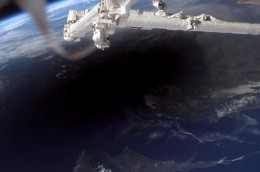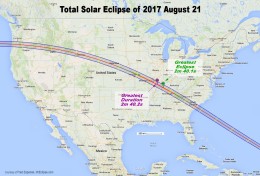Editor’s note: This week we’re in Boulder, Colorado at the 47th meeting of the AAS Solar Physics Division (SPD). Follow along to catch some of the latest news from the field of solar physics!
Yesterday’s press conference was titled “Preparing for the 2017 Great American Eclipse.” Four speakers highlighted both outreach and research projects that are planned for the eclipse that will cross the continental United States on August 21st next year.
Eclipse from High Altitude
First up, Angela Des Jardins (Montana Space Grant Consortium) introduced us to the nationwide Eclipse Ballooning Project.

An eclipse as seen from the ISS. Being up high gives you a very different perspective on eclipses! [NASA]
And what better way to experience the eclipse than to be involved? The Eclipse Ballooning Project is involving more than 50 student teams from 30 states to fly high-altitude balloons at 20 locations along the total eclipse path. These balloons will send live videos and images from the edge of space to the NASA website.
Why? Being someplace high up provides an entirely different view for an eclipse! Instead of looking up to watch the Moon slide in front of the Sun, you can look down to watch the Moon’s shadow race across the Earth’s surface at thousands of miles per hour. This unique perspective is rare, and has certainly never been covered live. This will be an awesome addition to other coverage of the eclipse!
At Maximum Totality
The next speaker, Gordon Emslie, described the outreach efforts planned at his institution, Western Kentucky University (WKU). The location where the eclipse totality will last the longest — 2 minutes and 40 seconds — is the small town of Hopkinsville, KY. WKU is located a little over an hour away, and both locations are prepared for a large influx of people on eclipse day!
WKU is located just off the centerline of eclipse path, which has some advantages: this provides better viewing of some of the chromospheric features of the Sun during the eclipse, like priminences and solar loops. WKU is setting up a variety of educational and public outreach activities at their football stadium and the WKU farm, and they encourage you to come visit for the eclipse!In addition, they are participating in a nationwide experiment called Citizen CATE, short for the Continental American Telescopic Eclipse. This project will use 60 telescopes spanning the 2500 mile path of totality to record continuous data of the eclipse as it travels across the US. The result will be data of a remarkable 90 minutes of totality, revealing the activity of the solar corona and providing an extended view of the eclipse as has never been seen before.
Science During the Eclipse
Next up was Shadia Habbal (University of Hawaii), who is a co-leader of the AAS 2017 Eclipse Task Force. In addition to her education and outreach efforts associated with the eclipse, however, Habbal is a solar eclipse researcher. She and her collaborators are known as the Solar Wind Sherpas, due to the fact that they hand-carry their science equipment around the world for solar eclipses!
![Solar corona during a 2008 eclipse, with color overlay indicating emission from highly ionized iron lines. [Habbal et al. 2010]](https://aasnova.org/wp-content/uploads/2016/06/figIRON-260x197.jpg)
Solar corona during a 2008 eclipse, with color overlay indicating emission from highly ionized iron lines. [Habbal et al. 2010]
Unfortunately, the space telescopes that observe the Sun all have relatively narrow fields of view. But during an eclipse, we can gain the larger context for the corona with ground-based observations, with the Moon conveniently blocking the light from the Sun’s disk! The cover photo is a spectacular example of this.
Observations of the corona during eclipses can provide information on both enormous events, like coronal mass ejections, and faint dynamical features, like plasma instabilities and expanding loops. In addition, we can learn about the plasma properties by examining emission from highly charged ions. The upcoming eclipse should provide a great opportunity to do some coronal science!
A Unique Opportunity
The final press-conference speaker for the meeting was Jay Pasachoff (Williams College and Caltech), a veteran solar eclipse observer who was able to speak to what we could expect if we make it into the path of totality next year.
Pasachoff pointed out that there are nearly 12 million people located within the band of totality. There are probably another 200 million within a day’s drive! He strongly encouraged anyone able to make it to the path of totality to do so, pointing out that the experience in person is completely unlike the experience of watching a video. The process of watching the world around you go dark, he says, is something that simply isn’t captured when you watch an eclipse on TV.If you plan to travel for the eclipse, Pasachoff’s recommendation is to aim for the northwest end of the path of totality, rather than the southeast end — surprisingly, weather statistics suggest you have a better chance of not getting clouded out in the northwest.
We now have a year left to educate everyone likely to view the eclipse on when and how to view it safely! Accordingly, Pasachoff concluded the conference by providing a series of links on where to find more information:
eclipses.info
totalsolareclipse.org
GreatAmericanEclipse.com
eclipsophile.com


![Partial solar eclipse as viewed by the space-based Solar Dynamics Observatory. [NASA/SDO]](https://aasnova.org/wp-content/uploads/2016/06/figSDO-260x260.jpg)

1 Comment
Pingback: Allgemeines Live-Blog ab dem 29. Mai 2016 | Skyweek Zwei Punkt Null